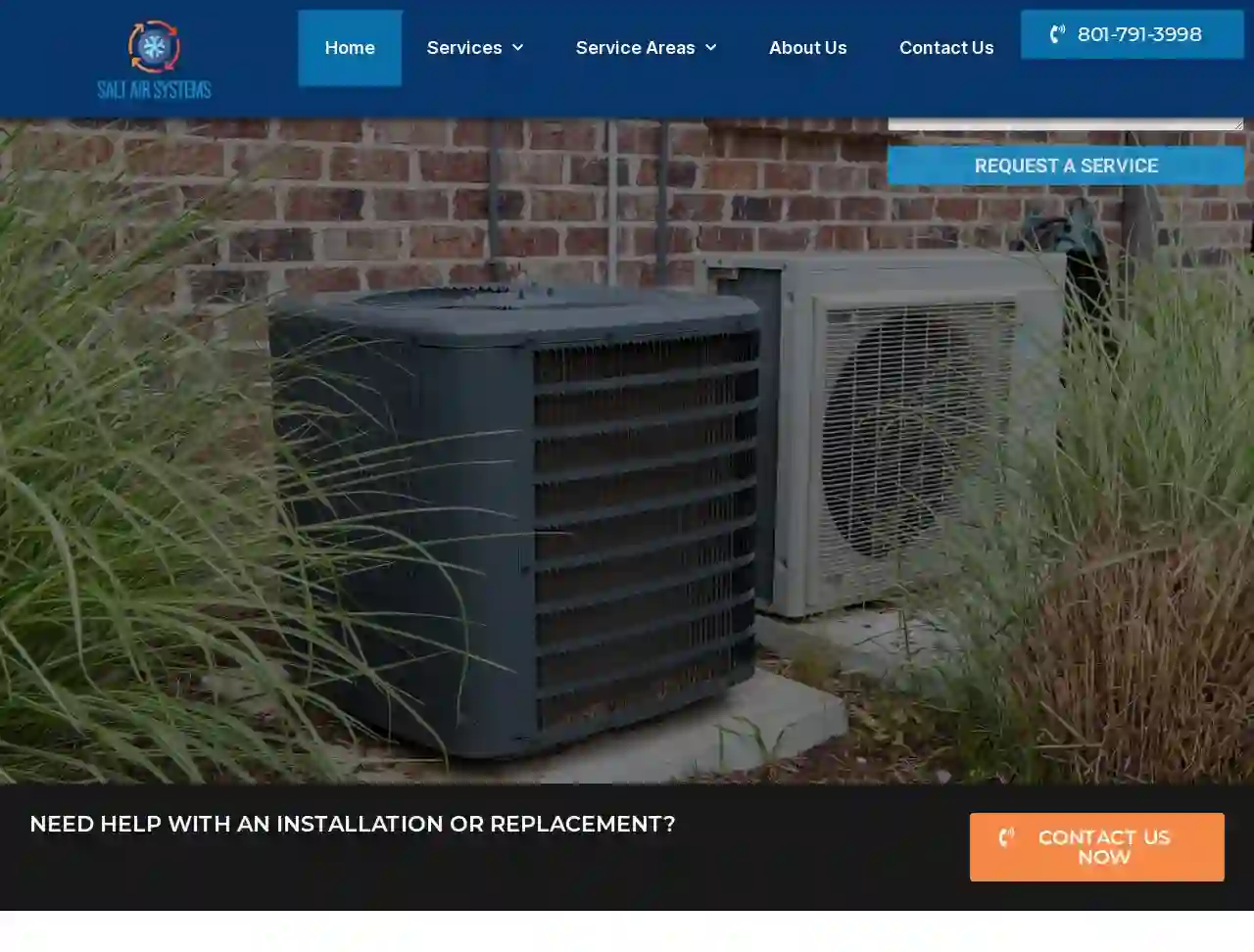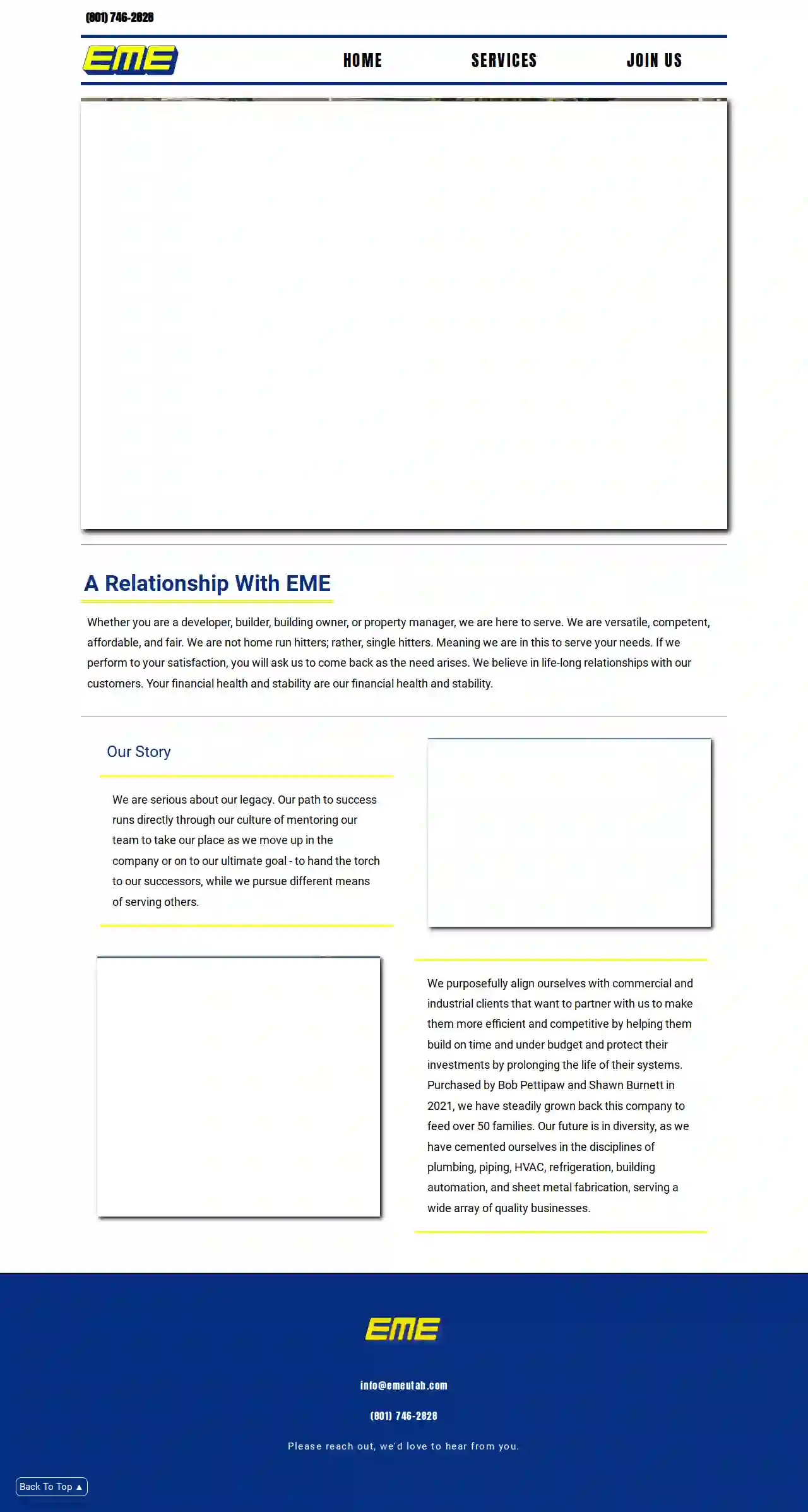Boiler Installation Elk Ridge
Find Boiler Replacement in Elk Ridge
Get 3 FREE Boiler Replacement quotes for your project today! Compare profiles, reviews, accreditations, portfolio, etc... and choose the best deal.

Salt Air Systems
54 reviewsRoy, Utah, 84067, USAt Salt Air Systems, we understand the importance of having a comfortable home environment while keeping energy usage low. That's why we provide quality HVAC installation services, maintenance, and repair to help you make the most of your system. Our experienced technicians are dedicated to providing you with exceptional HVAC systems and service. We start every project by conducting an initial consultation to learn more about your preferences. Our technicians will then provide a detailed plan for the installation process, taking into account your specific needs. We use top-quality products from leading brands and ensure that all components are installed correctly. Once the system is in place, our technicians take all the necessary steps to ensure its efficient performance over time. They will check for any potential issues, such as improper airflow or insufficient insulation, that may be affecting its efficiency and address them quickly. Furthermore, they can advise on energy-saving tips and provide regular maintenance services to keep your HVAC system running at peak performance levels.
- Services
- Why Us?
- Gallery
Get Quote
HK Mechanical
4.9225 reviewsOgden, USHK Mechanical is a locally owned and insured Greater Salt Lake AC repair and furnace repair contractor. We offer honest HVAC services that go above and beyond our competitors. We offer 24/7 HVAC repair! Our services include: AC Repair, Installation, and Maintenance, Furnace Repair, Installation, and Maintenance, Boiler Repair, Installation, and Maintenance, and Indoor Air Quality System Installations. We understand exactly how stressful it can be to deal with AC repair or furnace repair issues in your household. Here at HK Mechanical, we strive to make this experience as simple and stress-free as possible for you and your family. With our 25 years of combined experience, our top priority is to ensure you receive 5-star service when you turn to us for Layton HVAC repair. Our goal is to exceed our client’s expectations. It is just two guys with over 25 combined years of experience. We were tired of working for people who were not putting the customer first and working for those who only want to turn techs into salesmen.
- Services
- Why Us?
- Our Team
- Testimonials
- Gallery
Get Quote
Apgar Oil Energy & HVAC
4.573 reviewsAllentown, PA, 639 E. Congress Street, 18109, USWelcome to Apgar Oil! Apgar Oil Energy & HVAC is a locally owned family business offering reliable heating, air conditioning, and oil tank replacement service to Lehigh Valley homes. We have been delivering heating oil, installing HVAC energy equipment, and performing oil burner repair and other maintenance services in the Allentown, Bethlehem, Easton, and Greater Lehigh Valley areas of Pennsylvania since 1947. With advancements in renewable fuels and energy technologies, we are proud to offer clean, green Bioheat® fuel delivery, solar hot water options, and more. Serving the Lehigh Valley Since 1947
- Services
- Why Us?
- Accreditations
- Gallery
Get Quote
EME MECHANICAL
54 reviewsSalt Lake City, USServing northern Utah for nearly 40 years, EME is dedicated to building lasting relationships with our clients. Whether you're a developer, builder, building owner, or property manager, we offer versatile, competent, and affordable services tailored to your needs. We believe in a collaborative approach, working closely with you to ensure your financial health and stability are our top priorities. Our commitment to excellence is reflected in our culture of mentoring and developing our team, preparing them to take on leadership roles and ultimately hand the torch to the next generation. We strive to partner with commercial and industrial clients, helping them achieve greater efficiency and competitiveness by delivering projects on time and under budget while protecting their investments through long-lasting system solutions. Since 2021, under the ownership of Bob Pettipaw and Shawn Burnett, EME has grown to support over 50 families. Our diverse expertise spans plumbing, piping, HVAC, refrigeration, building automation, and sheet metal fabrication, allowing us to serve a wide range of quality businesses across various industries.
- Services
- Why Us?
- Gallery
Get Quote
Superior Water & Air
4.8233 reviews3536 S 1950 W, Salt Lake City, 84119, USAt Superior Water & Air, our number one goal is to keep your home comfortable and your systems running smoothly. Proudly serving Utah for the past several years, we offer a wide range of services to help you achieve clean and comfortable living. From drain cleaning to HVAC installation and repair, our expert team is dedicated to providing superior solutions for your home or business needs.
- Services
- Why Us?
- Gallery
Get Quote
Lehigh Valley HVAC Pros
Lehi, USDelivering Amazing HVAC Quality & Indoor Comfort to the Lehigh Valley. Same Day Service, Upfront Pricing & Service Guarantee. We install state-of-the-art high efficiency residential air conditioning units. Having trouble with your heater? We can discover possible leaks in your home. With routine maintenance you can expect lower heating and cooling costs. We are certified to work on a variety of HVAC systems in commercial properties. Lehigh Valley HVAC Services 24/7! A set of service only for you. Save time and money with installation service. If you need quick repair, we offer it for homeowners and all customers. Quick and regular servicing guarantees means a long use. With routine professional maintenance you can expect lower heating and cooling costs. We recommend scheduling preventive maintenance to ensure your HVAC system runs efficiently and effectively.
- Services
- Why Us?
- Gallery
Get Quote
Imperial Heating & Air
55 reviewsWest Haven, USImperial Heating & Air is a professional HVAC company in West Haven, UT with nearly 2 decades of experience in the industry. We are committed to providing our clients with superior service and results. We offer a variety of services such as AC repair, HVAC maintenance, gas line installation, and more. Contact us today for a free consultation on your next construction project! Experienced Staff Countless Satisfied Clients PROFESSIONAL WORK WITH PROFESSIONAL SERVICES
- Services
- Why Us?
- Gallery
Get Quote
Sami James HVAC Services LLC
59 reviewsRiverton Utah, 4613 W Sentry Dr, Riverton, 84096, USSami James HVAC Services LLC is a faith-based company that provides honest, professional, and affordable HVAC installation and repair services. We have a team of highly skilled and experienced technicians who are committed to getting the job done correctly 100% of the time. Our goal is to make a positive influence within our community by utilizing business practices that promote an honest and trustworthy relationship with our customers. We offer 24/7 emergency HVAC service, preventative maintenance, and a wide range of services to optimize your system's efficiency. Our company is committed to providing quality service and customer satisfaction.
- Services
- Why Us?
- Testimonials
- Gallery
Get Quote
Harris Aire Serv
4.8311 reviews123 Main St, Salt Lake City, 84115, USHarris Aire Serv is a locally owned and operated HVAC company serving Salt Lake City and the surrounding areas. We offer a range of services, including HVAC repair, maintenance, and installation. Our team of expert service professionals is dedicated to providing top-notch service and ensuring your comfort and satisfaction. With our upfront pricing, no overtime charge, and on-the-way alerts, you can trust us to get the job done right. We're committed to being your go-to HVAC company for all your heating and cooling needs.
- Services
- Why Us?
- Gallery
Get Quote
HVAC Distributors
3.73 reviewsLehi, US- Services
- Why Us?
- Accreditations
- Gallery
Get Quote
Over 15,611+ HVAC Contractors registered
Our HVAC contractors operate in Elk Ridge & surrounding areas!
HVACCompaniesHub has curated and vetted Top HVAC Companies arround Elk Ridge. Find the most reliable pro today.
Frequently Asked Questions About Boiler Installation
- Age: If your boiler is more than 15 years old, you should probably consider replacing it. Newer boilers can significantly reduce energy bills.
- Frequent Repairs: Multiple service calls in recent years can be a sign of more problems to come. In some situations, replacing the system is more sensible.
- Inconsistent Heating: If your boiler struggles to heat your home evenly , it could be failing.
- Leaks and Drips: Any water leaks around your boiler require immediate professional service.
- Unusual Noises: Gurgling, rumbling, or clanking sounds coming from your boiler indicate a potential problem that needs investigating. .
- Increasing Energy Bills: Higher utility costs, even with no changes in temperature settings, could be caused by a decrease in boiler efficiency.
- Yellow Flame: If the flame in your gas boiler is yellow instead of blue, it could indicate incomplete combustion, a sign that your boiler may need professional attention Contact a technician right away.
What is the difference between a regular boiler and a system boiler?
Can I install a boiler myself?
Do I need a new boiler?
How do I reset my boiler?
What is the difference between a regular boiler and a system boiler?
Can I install a boiler myself?
Do I need a new boiler?
- Age: If your boiler is more than 15 years old, you should probably consider replacing it. Newer boilers can significantly reduce energy bills.
- Frequent Repairs: Frequent repairs can be a sign that it is more cost-effective to replace your boiler. .
- Inconsistent Heating: If your boiler struggles to heat your home evenly , it may be time for a new one. .
- Leaks and Drips: Any dripping water around your boiler indicate a problem and should be addressed by a professional immediately. .
- Unusual Noises: Gurgling, rumbling, or clanking sounds coming from your boiler indicate that it's not operating optimally.
- Increasing Energy Bills: A noticeable rise in your energy bills , even with no changes in temperature settings, could be a sign of a less efficient boiler. .
- Yellow Flame: If the flame in your gas boiler is yellow instead of blue, it could indicate incomplete combustion, a sign that your boiler may need to be serviced or replaced. A yellow flame can also mean a dangerous carbon monoxide leak, so have it checked immediately. .